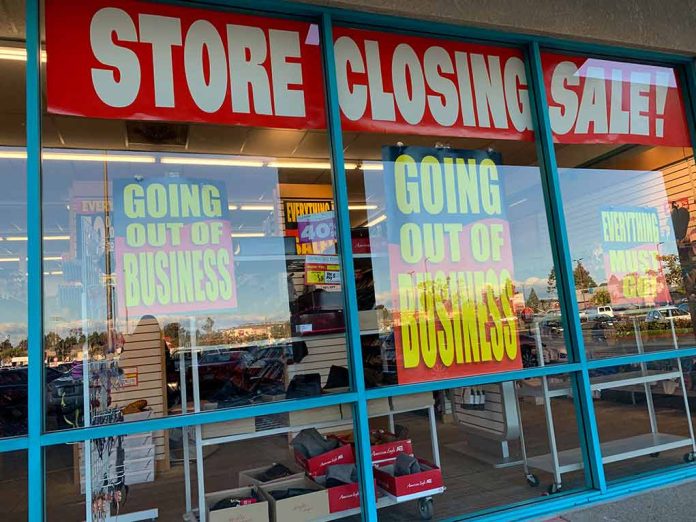
Conservative patriots, brace yourselves for another tale of corporate mismanagement and the consequences of poor decision-making. The once-mighty Rite Aid, a staple of American pharmacy retail, is crumbling before our eyes. As we dive into this analysis, prepare for a sobering reminder of how even giants can fall when they lose touch with their core values and customers. Let’s examine how this household name went from a corner drugstore to the corner of Bankruptcy Street and Bad Business Avenue.
The Numbers Don’t Lie
Rite Aid has closed a staggering 694 stores since filing for bankruptcy in October 2023. This represents a whopping 34% of the 2,063 stores the company operated at the time of filing for Chapter 11 bankruptcy. The latest round of closures hit Michigan and Ohio particularly hard, with 27 and 13 stores shuttering, respectively.
After these closures, Rite Aid will be left with just 58 stores in Michigan and 48 in Ohio. The company’s current biggest markets are now Pennsylvania, California, New York, Washington, and New Jersey, where they’ve managed to keep closures to a relatively lower percentage.
The Road to Bankruptcy
Rite Aid’s downfall can be attributed to a perfect storm of poor sales, legal troubles related to the opioid crisis, and fierce competition from larger chains like CVS, Walgreens, and Target. The company’s inability to adapt to changing market conditions and consumer preferences left it vulnerable in an increasingly competitive landscape.
Financial pressures on Rite Aid include significant debt and legal settlements due to their role in the opioid crisis. Additionally, cuts to Medicare and Medicaid reimbursements, along with the influence of Pharmacy Benefit Managers (PBMs), have contributed to the crisis by reducing reimbursements and setting high drug prices.
Impact on Communities
The closure of Rite Aid stores has far-reaching consequences, particularly in areas that may become pharmacy deserts. A University of Southern California study highlights that pharmacy deserts already affect 4.7 percent of the US population, and these closures will only exacerbate the problem.
“The World Health Organization has considered geographic access to pharmacies as one of the key determinants of access to essential medicines for decades.” – Dima M. Qato
For many patients, these closures mean disrupted access to essential medications and healthcare services. The impact is particularly severe for those with chronic conditions or limited mobility who rely on local pharmacies for their healthcare needs.
As Rite Aid continues to navigate its bankruptcy proceedings, the future remains uncertain for this once-ubiquitous pharmacy chain. The company’s struggle serves as a stark reminder of the challenges facing the retail pharmacy sector and the importance of adapting to changing market dynamics. For consumers and communities alike, the fallout from Rite Aid’s downfall will be felt for years to come.
Sources:
- Rite Aid Shutting Down More Stores as Total Closures Hit 694
- Rite Aid store closures top 75% in Michigan, 74% in Ohio
- “Pharmacy deserts” grow as Rite Aid closes most Michigan operations
- Rite Aid closing 10 more stores in Ohio
- Rite Aid shutting down 27 more locations
- Rite Aid closing dozens of additional stores
More from Around the Web:
RITE AID PLANS TO CLOSE HUNDREDS OF STORES AS PART OF BANKRUPTCY PLAN:
Bankruptcy-era hits Rite Aid hard:
Rite Aid store closures top 75% in Michigan, 74% in Ohio; total bankruptcy-era closures at 694 stores https://t.co/mJhkCavtQS
— abc27 News (@abc27News) July 28, 2024
Customers left high and dry:
The Rite Aid in my town is closing which sucks because the only other pharmacy in my town doesn't accept my current insurance.
— Eric Daugherty (@astroeric12) July 31, 2024






















